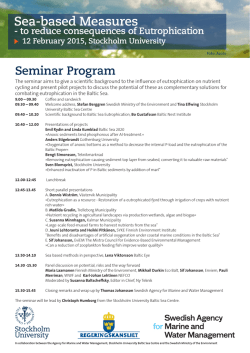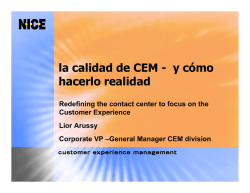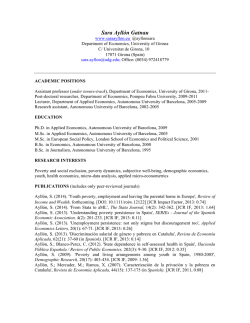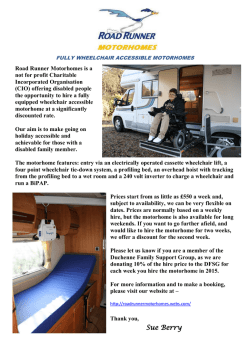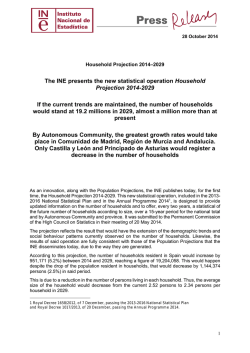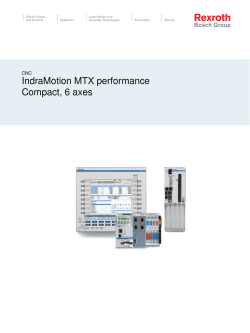
FY 2005 PI Report - National Oceanographic Partnership Program
Transitioning Submersible Chemical Analyzer Technologies for Sustained, Autonomous Observations from Profiling Moorings, Gliders and other AUVs PI: Alfred K. Hanson SubChem Systems, Inc. 665 North Main Road Jamestown, RI 02835 phone: (401) 783-4744 Ext. 102 fax: (401) 783-4744 email: [email protected] Grant Number: N00014-05-1-0647 http://www.subchem.com PI: Percy L. Donaghay University of Rhode Island, Graduate School of Oceanography South Ferry Road Narragansett, RI 02882 phone: (401) 874-6944 fax: (401) 874-6240 email: [email protected] Grant Number: N00014-05-1-0648 http://www.gso.uri.edu PI: Casey Moore WET Labs, Inc. PO Box 518 620 Applegate St. Philomath, OR 97370 phone: (541) 929-5650 fax: (541) 929-5277 email: [email protected] Grant Number: N00014-05-1-0649 http:// www.wetlabs.com PI: Richard Arrieta SPAWAR Systems Center – San Diego (SSC-SD) Ocean Technology Branch Code 2744 San Diego, California phone: (619) 553-1968 fax: (619) 553-1915 email: [email protected] Award Number: N00014-05-WX20853 http://www.spawar.navy.mil/sandiego LONG-TERM GOALS 1 To transition existing prototype autonomous profiling nutrient analyzers into commercial products that can be readily deployed on autonomous profiling moorings, coastal gliders and propeller driven unmanned underwater vehicles and used for sustained, autonomous ocean observations of chemical distributions and variability. A series of issues have been identified that that need to be addressed to convert prototype nutrient analyzers into commercial units that can be widely used by the community for sustained and accurate, stable, autonomous operation in the ocean. These issues are; (1) a more compact size, (2) reduced reagent and power consumption, (3) enhanced biofouling suppression, (4) ease of use by non-chemists, and (5) documented performance when deployed on different platforms. Our plan to address those issues involves using recent advances in micro-fluidics and optical detectors (new SubChem and WET Labs technologies) to reduce sample flow rates and volumes and thus reagent and power consumption; (2) extend the length of field deployments by periodically isolating sensitive components so that back-flushing and chemical techniques can be used to suppress biofouling, (3) increase the ease of use by simplifying operation, pre-packaging reagents and outputting the data in engineering units, and (4) thoroughly documenting the performance by conducting demonstration experiments at field sites that have strong vertical and horizontal nutrient gradients and episodic phytoplankton blooms. We intend to achieve these goals through this NOPP partnership. The industry partners will take the lead in developing the commercial versions of the nutrient analyzers while the university and government partners will provide guidance defining the initial performance criteria for the nutrient analyzers and in providing the deployment platforms and conducting the field testing and demonstration experiments. OBJECTIVES The primary objectives of this collaborative NOPP project are the technological advancement, verification, demonstration and commercialization of two autonomous profiling nutrient analyzers that have been developed to their present status with government and private funding. The Autonomous Profiling Nutrient Analyzer (APNA) and the Micro-AUV Ready Chemical Analyzer (MARCHEM) will be improved so that they are capable of deployment from profiling moorings, coastal gliders and other AUVs for sustained, autonomous ocean observations of nutrient concentrations, spatial distributions and temporal variability. APPROACH Our general approach to achieve these objectives involves a collaborative partnership between industry (Alfred Hanson, SubChem Systems, Inc., and Casey Moore, WET Labs, Inc.), university (Percy Donaghay, University of Rhode Island) and government (Richard Arrieta, SPAWAR Systems Center San Diego). These partners have extensive experience in working together to develop and test new sensing and deployment systems and then collaborating through ONR, SBIR and NOPP programs to commercialize those technologies for use by the broader community. For example, the original finescale nutrient profiler developed by Hanson and Donaghay (1998) under ONR funding was subsequently commercialized into the SubChemPak nutrient analyzer by Hanson and Moore (2001). The APNA prototype was developed by Hanson, Moore and Donaghay as part of an earlier NOPP project which also developed the ORCAS autonomous profiler (IOPC). Similarly, Arrieta and Hanson 2 worked together on a major Navy field experiment in 2003 that involved testing new chemical analyzer payloads and REMUS vehicles to track underwater plumes of chemicals (Arrieta et al., 2003; Ferrell et al, 2003). An existing APNA prototype will be modified by SubChem Systems and WET Labs to be a more compact, resource-efficient, autonomous profiling multi-nutrient analyzer (referred to as APNA II), particularly suited for sustained deployments on autonomous moored profiling systems like the IOPC profiler, and other AUVs. The MARCHEM analyzer prototype will be similarly developed, but as very compact single channel analyzer designed for ready deployment on autonomous underwater vehicles that have more stringent space and power limitations (i.e. coastal gliders and small UUVs). Both of these analyzers will utilize similar miniaturized electro fluidic, optical detection and instrument communication and control components to accomplish the autonomous chemical analysis with minimal utilization of power and reagents. The academic and government partners, URI-GSO and SPAWAR-SSC, will contribute to the further development of these nutrient analyzers by providing advice and guidance on the analyzer design and specifications for the purpose of integration onto specific oceanographic platforms and accomplishing specific scientific and ocean observation goals. As they are developed, the MARCHEM and APNA II analyzers will be tested and demonstrated in the field by integrating and deploying them on various autonomous underwater vehicle test platforms, such as the ORCAS IOPC profiler (URI), REMUS AUV, and Slocum coastal gliders (SPAWARSSC). WORK COMPLETED Progress was made on multiple objectives during the first fiscal year (6 months) of funding. 1) Fabrication and integration of new nutrient analyzers into the IOPC profiler and REMUS AUV: Two new submersible nutrient analyzers were designed, fabricated, tested and deployed in the field. The first was a new generation the autonomous profiling nutrient analyzer (APNA II), a four channel autonomous profiling nutrient analyzer (nitrate, nitrite, phosphate, ammonia) that was tested on URI’s IOPC profiler (Figure 1). The second was a new generation of the MARCHEM analyzer configured for the determination of ammonia and deployment as a payload on a REMUS vehicle (Figure 2). The APNA II and MARCHEM analyzers were designed and fabricated by SubChem Systems, WET Labs provided the optical detectors and detector electronics, and the URI and SPAWAR partners provided guidance on the design and specification for the analyzers. Both analyzers were tested in Monterey Bay during Aug.- Sept. 2005, during a field effort sponsored by the ONR directed research initiative “Layered Organization in the Coastal Ocean (LOCO)”. WET Labs and SubChem engineers worked with the URI Scientists to integrate and test the APNA II on the previously designed IOPC profiler. WET Labs specific efforts involved adapting the profiler’s control and acquisition software to accommodate the new APNA II. SubChem Systems installed the MARCHEM payload onto the URI REMUS vehicle and conducted three AUV missions during the LOCO experiment. 2) New pumping, mixing and sensing components: WET Labs and SubChem Systems nutrient analyzer development efforts are being collectively focused on three primary topical areas. These areas include developing improved fluidic pumping technologies, integrated optical sensing and mixing capabilities, advancing sensor technologies, and solving integration issues 3 for autonomous profiling platforms. Our goals in improving existing fluidics and sensing capabilities of the chemical sensors involve testing and implementing new and improved pumps, providing fewer discrete fluidic junctions, improving ease of manufacturing, reducing overall fluid requirements and improving over-all measurement stability and precision. For example WET Labs is investigating the utility of a new design for a single mixing manifold that replaces the tubing system employed previously. Similarly, SubChem Systems introduced a new type of micropump into the APNA II and MARCHEM Analyzers. The new pumps allowed analytical flow rates to be reduced by 80% which lead to a commensurate reduction in reagent usage and power consumption. The development of new fluidic and integrated fluidicdetection technologies is required for the successful adaptation of APNA and MARCHEM for sustained autonomous deployments on profiling moorings and gliders. 3) Integration of MARCHEM into the Slocum Glider: SPAWAR scientists and engineers provided initial consultation and guidance to SubChem Systems for modifications to the MARCHEM analyzer design and specification for the purpose of future integration and testing on the Slocum Glider (planned for FY 06-07). RESULTS The field testing of the two new nutrient analyzers that was just completed in Monterey Bay, within the matrix of the ONR LOCO “Thin Plankton Layers” experiment, has provided some interesting results. At this time, we have only had the opportunity to examine a portion of the data that was collected during the 6-week field effort. The time series of five hourly high-resolution vertical nutrient profiles, shown in Figure 3, were obtained during a test deployment of the APNA-II on the URI IOPC profiler. The IOPC was programmed to turn on and off the APNA II, so it would acquire nutrient concentration data ( 1 reading per second) while the package ascended through the water column. The ascent rate was set at ~3 cm/sec in order to maximize the vertical resolution of the measurements. When the IOPC reached the surface after each profile, the nutrient data was transferred from the APNA’s flash memory, via radio telemetry, to shipboard and land-based receiver stations. The analytical results from the APNA II indicated that the concentration of nitrate varied from ~0.05 micromolar or less in the near surface waters to greater than 6 micromolar in the near-bottom waters. The concentration of nitrite varied from 0.02 micromolar or less in the near surface up to 0.5 micromolar in deeper waters. Careful comparison of the hourly profiles for nitrate and nitrite, with the vertical profiles of salinity and temperature, reveals that the steep nutrient gradients and fine-scale nutrient variability are highly correlated with both the major gradients and the fine-scale variations in salinity and temperature. A series of water samples were collected and frozen for future comparative analyses by conventional laboratory autoanalyzer. The cold water temperatures in Monterey Bay presented a challenge, particularly for determining ammonia and phosphate in situ, since heating of the sample water is required to optimize the signal response time of the APNA II for high-resolution continuous profiling of these nutrients. These autonomous vertical profiling results are very comparable to earlier results obtained in East Sound, WA, using a ship-deployed high resolution nutrient profiler (Hanson and Donaghay, 1998). The analytical results obtained for ammonia are shown in Figure 4 for a sixty minute REMUSMARCHEM test mission in Monterey Bay. In addition to the MARCHEM ammonia analyzer, the REMUS vehicle also had sensors for current velocity and direction, CTD, oxygen, chlorophyll 4 fluoresence, CDOM fluoresence, and particle scattering. The vehicle was pre-programmed to undulate between 2-18 meters (bottom depth ~ 20 meters). The descent and ascent rates were adjusted to be slow ( ~2 cm/sec) in order to maximize the vertical resolution of the measurements. The results from each REMUS mission were downloaded from the vehicle after the mission was completed. The concentrations of ammonia detected in Monterey Bay were very low in the surface waters (~0.1 micromolar), increased sharply through the thermocline to substantially higher levels in the near bottom waters (6.3 micromolar at 17 m). A series of water samples were also collected and frozen for future comparative analyses by conventional laboratory autoanalyzer. IMPACT/APPLICATIONS Economic Development It is a critical gap that the oceanographic community does not currently have the capability to make routine and sustained nutrient measurements, in situ and autonomously, at the same space and time scales that are possible for temperature, salinity, oxygen, and chlorophyll fluorescence. The on-going research for this NOPP project is giving us the opportunity to further develop and demonstrate autonomous chemical profiling technologies. The successful deployments of; 1) the APNA II on the IOPC profiler and 2) the MARCHEM ammonia analyzer on the REMUS vehicle, both represent substantial advancements in the development of this technology and bring us much closer to a demonstrated capability for sustained, autonomous ocean observations of nutrient distributions and variability. RELATED PROJECTS A related project is the ONR sponsored Directed Research Initiative entitled “Layered Organization in the Coastal Ocean (LOCO)”. The LOCO program is focused on developing an understanding of the dynamics of thin plankton layers in coastal waters. As the new nutrient monitoring technologies being developed in this NOPP project are demonstrated and available for field applications, then they will be utilized within the LOCO field research. PIs Hanson (SubChem) and Donaghay (URI) both have LOCO projects. REFERENCES Arrieta, R., Farrell, J., Granger, B., Djapic, V. 2003. Adaptive Mission Planning: Using UUV’s to Trace Chemical Plumes and Declare Source Locations. IEEE OES Homeland Security Technology Workshop 2003. Warwick, RI Farrell, W. Li, S. Pang, R. Arrieta, 2003. Chemical Plume Tracing Experimental Results with a REMUS AUV, MTS/IEEE Oceans, pp. 962-968. Hanson, A.K. and P.L. Donaghay. 1998. Micro- to Fine-Scale Chemical Gradients and Layers in Stratified Coastal Waters. Oceanography, 11(1):10-17. Hanson, A.K. and C. Moore, 2001. Real-Time Nutrient Surveys in Coastal Waters, Sea Technology, 42(9): 10-14. 5 Figure 1. URI Scientists deploying the IOPC profiler with the newly developed APNA II nutrient analyzer payload in Monterey Bay from the R/V Shana Rae. [The URI IOPC profiler is an autonomous, battery operated moored-profiler that may be deployed in the coastal ocean for weeks at a time. It contains a full suite of instruments and sensors for monitoring the physical, optical, biological and chemical properties of the water. The profiler can be programmed to make repeated profiles, from the bottom to the surface, on a pre-set time schedule, to send the results by radio telemetry to a shore- or ship-based receiver station, and then return to the bottom to wait for the time to start the next profile.] Figure 2. URI’s REMUS vehicle with the MARCHEM ammonia analyzer payload ready for deployment from the R/V Shana Rae into Monterey Bay, CA. [The MARCHEM Analyzer is the black module located immediately behind the white nose cone, which contains the small inlet filter for the analyzer. The green module is the RDI Acoustic Doppler Current Profiler (ADCP). The CTD, Oxygen, Chlorophyll and CDOM fluorescence and particle scattering sensors are installed in the black module located between MARCHEM and the ADCP.] 6 NO + NO (µM) 2 0 0 1 3 2 3 4 5 6 Depth 5 10 15 Local Time 10:43 11:43 13:28 14:33 15:33 20 Salinity (ppm) 33.45 0 33.5 33.55 33.6 33.65 33.7 Depth 5 10 Local Time 10:43 11:43 13:28 14:33 15:33 15 20 Temperature (°C) 12 0 12.5 13 13.5 14 14.5 15 15.5 16 Depth 5 10 Local Time 10:43 11:43 13:28 14:33 15:33 15 20 Figure 3. A graph showing the results from a time series of five hourly high-resolution vertical nutrient profiles that were obtained autonomously in Monterey Bay, CA during a test deployment of the APNA-II multi-nutrient analyzer on the URI IOPC profiler (shown in Figure 1). [The concentration of nitrate varied from ~0.05 micromolar in the near surface waters to greater than 6 micromolar in the near-bottom waters. The concentration of nitrite varied from 0.02 micromolar in the near surface up to 0.5 micromolar in deeper waters. The steep nutrient gradients and fine-scale nutrient variability are highly correlated with both the major gradients and the fine-scale variations in salinity and temperature.] 7 NH3 (µM) 0 6 −2 −4 5 −6 Depth (m) 4 −8 −10 3 −12 2 −14 1 −16 −18 20 30 40 50 Elapsed Time (min) 60 70 80 Figure 4. A graph showing the ammonia concentrations measured while underway undulating between near the surface and near the bottom in Monterey Bay, CA during a sixty minute autonomous REMUS mission with the MARCHEM analyzer payload (shown in Figure 2). [The concentrations of ammonia detected in Monterey Bay were very low in the surface waters (~0.1 micromolar), increased sharply through the thermocline to substantially higher levels in the near bottom waters (6.3 micromolar at 17 m).] 8
© Copyright 2025
